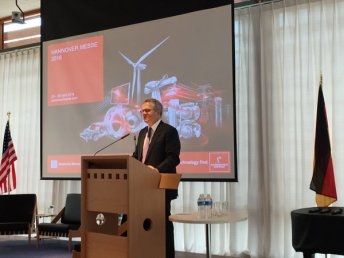Apr082016
Posted at 11:08 AM
This post originally appeared on the Siemens Blog.
Hannover Messe is the world’s largest industrial technology trade fair and it is fitting that the United States will serve as this year’s partner country as the U.S. and Germany deepen and broaden cooperation in shaping the new age of industry – combining Germany’s engineering prowess with America’s leadership in software. Siemens has been a Hannover Messe exhibitor since the inaugural fair in 1947, and with investments of $35 billion in the U.S. over the past 15 years, Siemens plays an important role in advancing the future of U.S. manufacturing. To learn more and for expert insights, sign up for their blog and follow @SiemensUSA
Earlier this week, I had a chance to join manufacturing leaders at the German Embassy to talk about the importance of the world’s largest industrial trade fair, Hannover Messe.
We are just a few weeks away from President Obama and Chancellor Merkel opening the fair together. And as U.S. Department of Commerce Deputy Secretary Bruce Andrews noted in his remarks, this underscores why the event is more than a trade show. “It’s an opportunity,” he said, “to discuss policy and show off the best of American industry.”
Later in the event, Jay Timmons, CEO of the National Association of Manufacturers, added that Hannover “stretches your imagination.” Global industrial leaders are there not only to demonstrate the best production, solutions and services of today, but to show the world what is possible in the future.
U.S. industry will have the Hannover spotlight like never before.
President Obama’s visit will mark the first appearance by a U.S. President and coincide with the United States’ debut as a partner country. And the U.S. delegation, led by Commerce Secretary Penny Pritzker, will be its largest ever, featuring more than 400 companies, economic development organizations, and research institutions.
At Siemens, we are excited to see American industry receive this positive exposure. The United States is both our largest market and a vital production center. We have more than 70 U.S. manufacturing sites and have invested $35 billion in America in the past 15 years.
Furthermore, the timing for American industry to assert its global leadership could not be better. Building off Jay Timmons’ point – what is possible in the future – Hannover is a focal point for the development of a new industrial age, or Fourth Industrial Revolution.
We are in a moment when everything that has happened in the consumer and retail space because of power advances in software is reaching the industrial world. There’s a transition underway from smartphones to smart factories that will bring unprecedented speed, efficiency, and flexibility to manufacturing operations.
Industry 4.0 is next – and the U.S. and Germany are natural partners in its pursuit. While Germany stands out as a leader in shop floor technology, the United States stands out as the world leader in software innovation, with more than 75 percent of software revenues generated by U.S. companies.
“When these two forces are combined,” German Ambassador Peter Wittig said, “they pave the way for the factory of the future.”
Ten years ago, would you have predicted a software company like Google would be represented at a manufacturing event? Today, Google, in addition to pioneering driverless cars, is striving to develop Industry 4.0 systems and platforms that are open-sourced yet secure from cyber threats, and interoperable. Another company we heard from yesterday, Local Motors – which used Siemens PLM software to create the world’s first 3-D printed car – did not even exist a decade ago.
This latter attribute, in particular, is essential. Without it, global Industry 4.0 value chains will never be achieved. Which is why, in his speech, Siegfried Russwurm, a member of our Managing Board and Chief Technology Officer of Siemens AG, made a strong case for continued international collaboration towards joint testing and the development of standards.
As we begin the Road to Hannover Messe, we’ll continue to explore how industry 4.0 is manufacturing our future in the U.S., demonstrating the importance of upgrading the national industrial base and embracing technology-driven enterprises. Economic shifts are also shining a spotlight on innovation as labor costs and energy prices are less impactful than before, and customers want to be near companies that offer the right technology and flexibility.
In the years to come, we could look back to the 2016 Hannover Messe as the year when Industry 4.0 became a common term, and when two industrial giants came together to chart a course towards making this term a global reality.




